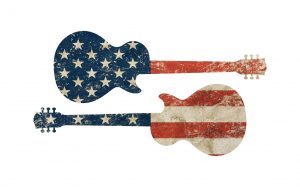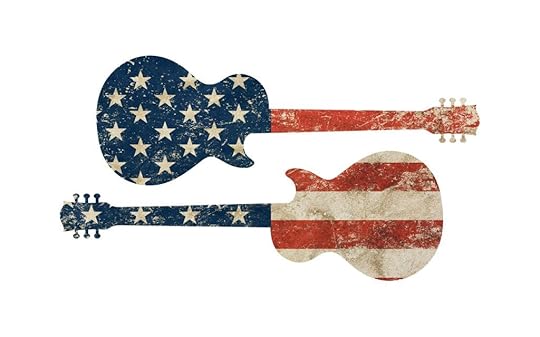Bathroom Readers' Institute's Blog, page 38
July 2, 2018
Behind “The Star-Spangled Banner”

Here’s some trivia about the U.S. National Anthem.

The Defense of Fort McHenry
While Francis Scott Key took the tune whole cloth from a 1700s drinking song called “To Anacreon in Heaven,” he wrote the lyrics after being eyewitness to the American victory at Fort McHenry, a battle during the War of 1812 against England. At the time, Key, a diplomat, was being temporarily imprisoned on an English ship off the coast of Baltimore. When he first wrote it, Key named it not “The Star-Spangled Banner” but the decidedly less catchy—if accurate—“The Defense of Fort McHenry.”
Shakespearean Roots
“Star-Spangled Banner” is about as American a phrase as possible—it conjures images of a parade of kids in red, white, and blue carrying it in a small town parade. (Sometimes Uncle John gets nostalgic for his youth.) But the title of the song about a battle with England comes straight out of…England. Both the phrase “by spangled star-light sheen” and “what stars do spangle heaven with such beauty” come from Shakespeare—A Midsummer Night’s Dream and The Taming of the Shrew, respectively.
Official National Anthem
While widely played and sung in the 19th century, “The Star-Spangled Banner” wasn’t made the official national anthem of the United States until 1931. Until then, there were strong and healthy contingents for everything from “America the Beautiful” to “Hail Columbia” to “Yankee Doodle Dandy.”
Three More Verses
Does it feel like the song ends a little ambiguously—especially because it ends with a question? It’s true: “O say does that Star-Spangled Banner yet wave / o’er the land of the free and the home of the brave?” Spoiler alert: Yes! But all is explained in more detail in the rest of the song. Yep—there’s more. The tune has four verses in all.
National Motto
Toward the end of the song’s fourth and final verse comes the lyric, “And this be our motto—in God is our trust.” Indeed, that is the national motto. It first appeared on a two-cent coin in 1864 and a joint resolution of Congress in 1956 called for it to appear on all American currency.
Fifth Verse?
But wait…there’s more! In 1861, popular American poet and abolitionist Oliver Wendell Holmes, Sr. wrote a fifth verse. Key had been a slaveholder, and when the Civil War broke out, the Confederacy reported wanted to claim “The Star-Spangled Banner” as its anthem. Holmes tried to end that drive by adding more lyrics that call for the end of human bondage.
Super Bowl Fame
It became a hit song…in 1991. Pop superstar Whitney Houston sang a powerful rendition of the National Anthem just before Super Bowl XXV, and recordings were sold to benefit military family-supporting charities. (The first Persian Gulf War was underway.) Houston’s version was certified gold and hit the top 20 of the hit parade. When re-released in the wake of 9/11, ten years later, “The Star-Spangled Banner” went Top 10.
The post Behind “The Star-Spangled Banner” appeared first on Trivia Books and Facts | Uncle John's Bathroom Reader.
June 29, 2018
A Brief and Meaty History of Vegetarian Fast Food

Over the last 20 years or so, more and more Americans have decided to cut down or eliminate meet from their diets. Vegetarianism is mainstream, and fast food companies have tried to meet those dietary demands by offering meat-free items alongside their usual fare of burgers and fried chicken. It hasn’t always worked out.
The upscale burger joint Shake Shack introduced a sandwich called the ‘Shroom Burger in 2014. It looks like a burger, but it isn’t a burger—in lieu of a beef patty, it incorporates a huge portobello mushroom that’s been fried and smothered in cheese. But “vegetarian” doesn’t necessarily mean “healthy.” The ‘Shroom Burger packs nearly 500 calories, or roughly 100 more than a regular Shake Shack hamburger. Additionally, the vegetarian option contains three times as much sodium as the meat version.
In 2002, Burger King quietly added the BK Veggie Burger to its national menu. The patty is made from soy, grains, and diced vegetables and is served wit all the Whopper accouterments. It’s perpetually ranked among of Burger King’s least popular menu items, but it made enough of a splash to rile competitor McDonald’s. In 2003, the chain debuted the McVeggie as the center of a “Salads and More” menu full of supposedly healthy offerings. One problem: the McVeggie had just as many calories as a Big Mac. The second problem: Not many people sought out McDonald’s for a soy burger, and the product was gone by the end of the year.
A company called Impossible Foods produces a highly processed and seasoned meat-free patty it calls the Impossible Burger. Reportedly tasting more like real beef than any other faux-burger that came before it, the company has gotten its product into chains including Fatburger and White Castle. Miracle product that replicates the taste of beef without all the calories and fat and grazing land necessary for large-scale cattle ranching? Maybe, but the FDA won’t sign off on whether the product’s so-called “magic” ingredient is safe for human consumption. The burgers contain heme, a molecule found in large amounts in animal tissue, but in trace amounts in soybean roots. Impossible uses a genetically-modified yeast to mass produce heme, a process about which the FDA is still on the fence.
For years, hungry vegetarians stuck on a road trip with nowhere more “suitable” to eat could at least rely on McDonald’s—they sell tons of French fries, and those are just made from potatoes, oil, and salt, right? Not really. Before the fries are sent to McDonald’s HQ, the supplier adds a number of chemicals and flavoring agents…including traces of beef.
The post A Brief and Meaty History of Vegetarian Fast Food appeared first on Trivia Books and Facts | Uncle John's Bathroom Reader.
The Worst World Cup Performances

Every four years, the greatest players from the greatest national teams across the globe come together to contest the FIFA World Cup of soccer. Some bask in the glory of victory forever…and then there are these guys.

Least successful national team
Some teams have dominated world soccer for decades. Brazil, for example, has won the World Cup five times and has qualified for all 21 tournaments to date. More than 20 countries, however, have made it to the World Cup only once. The team that has only been there once—and waits the longest for a return trip—is Cuba. The island nation’s national squad advanced to the quarterfinals of the third World Cup in 1938…and hasn’t been back since.
Most shocking non-qualification
Just behind Brazil on the “most World Cup appearances” list: Argentina. The legendary squad has only missed the World Cup one time—in 1970. Amidst a run of uncharacteristic chaos for the team (there were some problems with the Argentinean soccer federation, and the team went through four coaches in three years), the otherwise highly-ranked team bombed the South American World Cup qualifying tournament. They lost in rapid succession to Peru and Bolivia, and then took a 2-2 draw against Peru, canceling an assumed trip to the World Cup in Mexico.
Most lopsided games
World Cup soccer games tend to be low-scoring—the defense on these high-level teams is so good that teams have to be happy eking out a 1-0 win a lot of the time. But some squads are better than others, which results in the odd, and embarrassing, blowout. In 1954, Hungary set the record for most one-sided shutout—at the expense of South Korea. In both teams’ first game of the whole tournament, Hungary (which could go on to play, but lose, in the final), scored nine goals to South Korea’s zero. That result was matched 20 years later, in Yugoslavia’s 9-0 rout of Zaire. The Hungarian national team racked up another record in this category later on, beating El Salvador by nine points; the final score was 10 to 1, so at least El Salvador didn’t walk away empty-handed.
Biggest upset
It’s decidedly not a great moment for fans of Italy’s storied national team…but it’s one of incredible triumph for the North Korean team. In 1966, the isolated, dictator-run Asian nation reached the World Cup for the first time. Not as well-funded or established as some of the other teams in the tournament, North Korea was expected to make a quick exit after losing its initial, group stage matches. Indeed, the team lost its first game to the Soviet Union, but then surprisingly played to a draw with Chile, a championship contender. For game three, South Korea faced Italy, which needed only a draw to move on to the knockout round. Almost improbably, North Korea’s Pak Doo-ik scored just before the end of the first half. Final score: North Korea 1, Italy 0. The squad miraculously advanced to the next round…where Portugal dispatched them, 5 to 3.
The post The Worst World Cup Performances appeared first on Trivia Books and Facts | Uncle John's Bathroom Reader.
June 28, 2018
So Long, Jerry Springer
After 27 years and more than 4,000 episodes, The Jerry Springer Show is coming to a close. While Springer conducted himself with the dignity and poise of a talk show predecessor like Phil Donohue, the show usually involved angry people confronting each other about a personal issue, and then fighting each other. Here’s a look at the influence the show had on pop culture.

Politics!
A lot of politicians would do just about anything to boast the name recognition of Jerry Springer. In fact, before Springer was a talk show host, he was a journalist, and before that he was a politician. In 1971, he won a spot on the Cincinnati City Council, but had to resign in 1974 due to some Jerry Springer Show-ready circumstances—he was discovered to have solicited a prostitute…and paid with a check. After coming clean with the electorate, he won his seat back a year later and in 1977 he was appointed mayor of Cincinnati. In the 2000s, long after The Jerry Springer Show made him a household name, Springer almost ran for the U.S. Senate in 2000 and 2004. For the latter, Springer spent $1 million of his own money on an exploratory campaign, but ultimately decided the negative association of his own show cast him in a bad light.
Music!
Springer is apparently a man of many interests. In 1995, a tiny label called Fiddle Fish Records released his debut album called Dr. Talk. Not a bestseller, the collection consisted primarily of Springer gamely warbling his way through country music covers, such as Hank Williams’ “Cold, Cold Heart.” Springer was also the subject of other people’s music. On his 1999 album Running with Scissors, “Weird Al” Yankovic included “Jerry Springer,” a survey of Jerry Springer Show’s craziness, set to the tune of the rapid-fire Barenaked Ladies hit “One Week.”
Other Talk Shows!
The fist fights that inevitably broke out between angry guests on The Jerry Springer Show were such a staple that they made their dutiful peacemaker famous. The show utilized the services of a Marine and former police officer named Steve Wilkos as its head of security. The bald-headed fight-stopper became so well known that in 2007, Wilkos got his own very Jerry Springer-esque talk show (in that it features social issues and casual violence) called The Steve Wilkos Show. Springer serves as executive producer on that program.
Opera!
Jerry Springer: The Opera is definitely the best English-language opera ever produced about a patient daytime talk show host and his troubled guests who can’t help but throw punches at each other. Okay, it’s the only one, but still—it’s a real thing. Richard Thomas and Stewart Lee wrote the piece, which has been produced to huge success throughout Europe since 2001. Characters include Jerry Springer, Steve Wilkos…and the devil.
The post So Long, Jerry Springer appeared first on Trivia Books and Facts | Uncle John's Bathroom Reader.
June 27, 2018
Warts, Moles, and Birthmarks, Oh My!

Whether it’s wearing shorts and T-shirts to beat the heat, or swimwear to the beach or the pool, you can’t help but show a little more skin than usual in the summertime. Here’s some info about those little friends that are along for the ride.
What causes pimples?
Everything your mom and your doctor told you when you were a teenager is wrong—neither chocolate nor fatty foods lead to pimples, also known as zits or acne. Zits pop up and mar your pretty face when sebaceous (oil) glands at the base of hair follicles get clogged and become infected. That leads to small, red, pus-filled lesions. While they can occur at any time of life (great!), pimples are most associated with teenagers because of puberty. Adolescence means hormones working overtime, which makes sebaceous glands over-produce oil. More oil means an increased likelihood of oil glands clogging.
What causes warts?
While pimples are caused by oil—and your body working against itself—warts are the result of a virus. It infects the top-most layer of the skin and manifests as rough or smooth patch that may or may not be the same color as the skin itself. They generally come about if the skin has been disturbed or cut in some fashion, allowing the wart virus to find a way in. (Your mom was right about this one—since warts are virus-spread, you can get warts by touching other people’s warts.)
What causes moles?
Moles may look like warts, but they’re a completely different dermatological phenomenon. They’re skin growths, usually brown or black ones, that pop up when pigment-providing skin cells called melanocytes grow in a cluster instead of what they’re supposed to do, which is spread out and then grow. All that biological coloring agent inside those cells is what gives moles their signature hue.
What’s a skin tag then?
Often used interchangeably with moles and warts—skin tags are something else entirely, the result of purely external forces as opposed to the internal ones that lead to moles and warts. A skin tag, a floppy chunk of discolored, elevated skin, begins as a little bump that gets repeatedly rubbed by clothing or other skin. (Lots of skin tags appear on the side, under the arm, for example.) All that friction rubs and pulls at the same piece of skin, breaking skin cells until it’s just a little piece sitting atop the skin.
The post Warts, Moles, and Birthmarks, Oh My! appeared first on Trivia Books and Facts | Uncle John's Bathroom Reader.
Oh, Koko

Koko was probably the most famous real-life primate of all time. That’s because she was remarkable. Koko was a gorilla who learned to communicate with human beings through the use of sign language. Last week, Koko died at the age of 46—here’s a look back at her remarkable life.

Birth
Koko was specifically a western lowland gorilla. Born at the San Francisco Zoo in 1971, she spent her life at The Gorilla Foundation, located in the Santa Cruz Mountains in central California.
Name
“Koko” was merely a nickname. Her full name is Hanabiko, which in Japanese means “fireworks child.” That’s because Koko was born on the fourth of July, a big fireworks holiday.
Fame
Her claim to fame was, of course, her amazing abilities to converse with humans, and give us all a glimpse into how a gorilla’s mind works. She could listen to conversations, follow them, and used sign languages to talk. At the time of her death, she had an American Sign Language vocabulary of more than 2,000 words.
Pets
In addition to her communication abilities, Koko also gained fame and affection for being one of the most devoted cat-lovers in the world. The young gorilla so loved to look at cat-based picture books and story books that in 1984, she asked her team of researchers for a kitten. They provided a stuffed toy kitten, but Koko didn’t like it — she signed “sad” in regards to the toy. And so, on her next birthday, she got to pick out her own real kitten from a litter. The first one, which she named All Ball, became world famous as the star of the bestselling 1985 children’s book Koko’s Kitten. Sadly, All Ball escaped from Koko’s enclosure and was hit by a car (Koko reportedly cried for days and signed, “Sleep cat.”) Koko went on to have more cats, though—just three years ago, she adopted two kittens named Ms. Gray and Ms. Black.
“Family”
The Gorilla Foundation brought in an orphaned gorilla named Michael as a potential mate for Koko. They became best friends instead. When asked why she didn’t want to breed with Michael, Koko said he felt “like a brother.”
Grief
In the sixth months after Michael died, Koko was despondent – researchers said she didn’t smile at all, didn’t sign much, and ate less. In other words, she was mourning. In 2001, researchers brought in a guest—comedian and actor Robin Williams. The frenetic, energetic comedian helped Koko snap out of her depression as they laughed, and played games. They remained friends, so much so that when Williams died in 2014, Koko sensed something was wrong among her handlers and asked what had happened. They told her Williams died, and she went into mourning.
The post Oh, Koko appeared first on Trivia Books and Facts | Uncle John's Bathroom Reader.
June 26, 2018
They Died on the Pitch

The World Cup is a time of celebration and glory for soccer players and their billions of fans around the globe. But in pursuit of the most illustrious championship in sports, some athletes paid the ultimate price.

Sam Okwaraji
Nigerian-born midfielder Sam Okwaraji left home for Europe to earn a Ph.D., but he got a little sidetracked from his studies when he became a professional soccer player. He suited up for several teams in the 1980s, but joined Nigeria’s national team in 1988. In August 1989, Okwaraji’s squad squared off against Angola in an all-Africa World Cup qualifier—top finishers won spots in the 1990 FIFA World Cup. Near the end of the game, an Angolan player acted out and received a “red card” from an official—in other words, an ejection. He refused to leave the field and his teammates rallied to his side…while a few feet away, Okwaraji crumpled to the ground. Nigerian players ran to help him, but he had already died right there, in front of thousands of fans and millions watching on TV. Cause of death: The 25-year-old player had an enlarged heart and high blood pressure.
Marc-Vivien Foé
The FIFA Confederations Cup is nicknamed the “Mini World Cup”—it’s a tournament held every four years with teams from every continent along with the previous World Cup winner and the next World Cup’s host nation. In the 2003 Confederations Cup semifinal in France, Cameroon faced Colombia. As the game wound down with Cameroon holding on to a 1-0 lead, midfielder Marc-Vivien Foé suddenly stopped running and hit the ground. Medical staff took him off the field and gave him mouth-to-mouth resuscitation and tried in vain to re-start his heart. While his team finished the game, Foé died in the stadium’s medical area. An autopsy found that he had an undiagnosed ailment that caused enlarged heart cells and too-thick ventricular walls. Foé was only 28.
Andrés Escobar
Andrés Escobar didn’t die on the field…but a goof he made as part of the Colombian team in the 1994 World Cup would directly lead to his death. Colombia was expected to advance far into the tournament, and an early game against the usually so-so American team was thought to be a gimme for the South American powerhouse. With the score 0-0 as halftime approached, Andrés Escobar, a Colombian defender, misjudged a block and somehow kicked the ball into his own net. That made the score USA 1, Colombia 0. The Americans held out for the surprise win, and Colombia was soon eliminated from the tournament. Escobar returned to his hometown of Medellin, and as he left a restaurant one night at 3:30 a.m., he was assaulted by three men who shot him 12 times. (Police believe some of Colombia’s many crime bosses and cartels had a lot of money riding on the game…and Escobar ruined it for them.)
The post They Died on the Pitch appeared first on Trivia Books and Facts | Uncle John's Bathroom Reader.
June 21, 2018
Another Slam Dunk from the Little Emperor

The U.S. isn’t the only place where basketball is a big deal. The sport is incredibly popular in China, where both local stars as well as NBA icons are household names. Well, sort of, because they’re perhaps more widely known by their colorful nicknames.
LeBron James
In the U.S., the most dominant player of the day is known as “King James.” In China, they call him “The Little Emperor.”
Tony Parker
The Little French Sports Car. The relatively small (he’s 6’2”) and quick-footed San Antonio Spurs point guard is a native of France, so it makes sense that his nickname is “The Little French Sports Car.”
Russell Westbrook
Spelled out phonetically in Chinese, the Oklahoma City Thunder star’s name is “wei si te bu lu ke.” That’s pretty long, so they just call him “Wei Dude.”
Shaquille O’Neal
Over here, they called him Shaq. In Chinese, the word for shark is pronounced shayu, and that “sha-“ sounds a lot like “Shaq.” Result: In China, they call him “The Giant Shark.” (He is, after all, a pretty big guy.)
Giannis Antetokounmpo
Chinese fans call him “Letters Bro”…because the Milwaukee Bucks all-star does, in fact, have a lot of letters in his name.
Charles Barkley
The Round Mound of Rebound was unashamed of being one of the heaviest players to play the game. Chinese fans remind him of that with the kind of mean nickname “The Flying Pig.
Carmelo Anthony
His English nickname is a simple shortening of his first name—“Melo.” That sounds a lot like “melon,” so his nickname is the Chinese word for melon, pronounced “tian gua.”
Stephon Marbury
“Marxist Political Commissar” is the name of a Chinese government operative in the Communist country. Marbury’s nickname slides out the first word for a play on his name, or “Marburyist Political Commissar.”
Dirk Nowitzki
The dominating power forward and 2007 NBA MVP was one of the first German players to make a splash in the league. His nickname in China: “The German Panzer Tank.”
Klay Thompson
He’s “The Buddha.” We’re sure he has a great basketball mind, but the Golden State Warriors’ sharp-shooter reportedly earned this name because his short-cropped hair looks like the hair in traditional artistic renderings of Siddhartha Gautama, otherwise known as the Buddha. (Similarly, now-retired legend Tim Duncan was called “The Stone Buddha,” for a similar haircut and his unflappable demeanor.)
James Harden
“The Big Beard.” That’s self-explanatory.
Anthony Davis
“The Thick Brow.” That’s also self-explanatory.
The post Another Slam Dunk from the Little Emperor appeared first on Trivia Books and Facts | Uncle John's Bathroom Reader.
June 8, 2018
So Long, Anthony Bourdain

The beloved chef, food writer, and TV host who brought the world—and its flavors—into our homes has passed away at the age of 61. Here’s a look back on the life of a man who lived with No Reservations.

Don’t Eat Before You Read This
After working for years in some of New York’s best restaurants, Bourdain decided to give writing a try. In 1999, the 33-year-old chef wrote “Don’t Eat Before You Read This,” a gritty, warts-and-all behind-the-scenes look at what it’s like to work in a kitchen. (It’s not pretty.) He sent it unsolicited to the New Yorker, where it became so popular Bourdain got a deal to write a book-length expansion called Kitchen Confidential.
Publishing History
That book became a bestseller, and set Bourdain off on the path of writing about food, but it wasn’t the first book he published. In the ‘90s he published two crime novels, Bone in the Throat and Gone Bamboo. They didn’t sell well and quickly went out of print.
Defining a New TV Genre
Bourdain’s TV work originated a new TV genre: the food-based travelogue. Bourdain also wrote most of the narration himself. They’re commonplace on television and streaming services now, but he popularized the form with A Cook’s Tour on Food Network, No Reservations on the Travel Channel, and Parts Unknown on CNN.
Bradley Cooper as “Jack”
His only TV flop—a TV sitcom version of Kitchen Confidential. A pre-fame Bradley Cooper starred on the short-lived 2005 Fox series as Bourdain, who was renamed “Jack” for some reason.
Setting an Example
Bourdain was outspoken about a lot of things, but he saved his most vitriolic words for, ironically enough, other TV food personalities. He once called Paula Deen, the former Food Network expert on high-calorie and high-fat Southern cuisine, “the worst, most dangerous person in America.” When she revealed to the world that she had type 2 diabetes, Bourdain remarked, “When your signature dish is a hamburger in between a doughnut, and you’ve been cheerfully selling this stuff knowing all along that you’ve got type 2 diabetes, it’s in bad taste if nothing else. When Rachael Ray signed a deal with Dunkin’ Donuts, he likened it to “like endorsing crack for kids.”
Earning a Blue Belt
After his second marriage, to a mixed martial artist, Bourdain took up an interest in combat sports. He earned his blue belt in Brazilian jujitsu in 2015, and just a year later, won a gold medal in the age 56 and older division at the New York Spring International Open Championship.
Least Favorite Foods
While Bourdain ate all kinds of exotic, strange, and unfamiliar foods while shooting his shows Parts Unknown and No Reservations, he once said that the most disgusting he ever ate was…a Chicken McNugget from McDonald’s. (However, the two foods that he says he liked the least in his televised travels: warthog rectum in Namibia and fermented shark in Iceland.)
(P.S…..you will be missed.)
The post So Long, Anthony Bourdain appeared first on Trivia Books and Facts | Uncle John's Bathroom Reader.
June 7, 2018
This Band is a Bunch of Imposters!

Right now there’s probably a bar or club where a cover band is performing well-known songs originally made famous by other musicians. These stories are not about cover bands—they’re about people who tried to convince the world that they actually were those famous musicians…and they nearly got away with it.

Fake Fleetwood Mac
Before Fleetwood Mac became soft-rock superstars in the late 1970s with Stevie Nicks and Lindsey Buckingham co-fronting the band, the group originated in the late 1960s as a British blues-rock group. That incarnation fizzled out in 1973, but the band’s manager, Clifford Davis, wasn’t ready to let go of his cash cow. Claiming to own the rights to the name “Fleetwood Mac,” he recruited the members of an obscure British rock band called Legs and sent them out on the road under the name…Fleetwood Mac. The musicians agreed to it because Davis told them that actual Mac member Mick Fleetwood would join them on the road later on, and that another actual member of the real band, John McVie, had just up and quit. (At least, that’s what the fake Fleetwood Mac told angry fans who heckled them at their first tour date.) The tour fell apart not too long after, although during the legal proceedings that inevitably followed the gambit, it was revealed that Davis really did have the rights to “Fleetwood Mac” and while what he’d done may have been ethically ambiguous, it was within his legal rights to do so.
Fake Baha Men
You may not immediately recognize the name “Baha Men” but you definitely know their song. The Bahamas-based group had a monster hit in 2000 with “Who Let the Dogs Out?”—the party jam has been played over the P.A. at just about every sporting event since. Demand for the Baha Men to play live at games, on TV, and in concert was thus very high at the turn of the new millennium, combined with the fact that the group itself was still quite obscure, meant conditions were ripe for imitation. A group of musicians successfully played a series of paid gigs in and around England in 2000 and 2001, claiming to be the Baha Men. The actual Baha Men still have to separate fact from fiction. Numerous sources actually list the group’s country of origin as England (the fake band was from England; Baha Men are from the Bahamas—that’s where the “Baha” comes from). “We’re not affiliated with them in any way,” Baha Man Isaiah Taylor told Vice in 2015.
Fake Zombies
In 1967, the dreamy, spacy English pop-rock group the Zombies released their album Odessey and Oracle. While it would eventually be regarded as one of the greatest albums ever made (Rolling Stone ranked it at #80 on its all-time list), it was a little too weird and experimental for contemporary ears, and it flopped. As a result, the Zombies broke up. Oddly, two years later, the band’s record label released one of the songs, “Time of the Season,” in the U.S.…which zoomed to #3 on the pop chart. There was suddenly a market for a Zombies tour, so a company called Delta Promotions sent out on the road two different groups calling themselves the Zombies. Since nobody knew what the actual members of some random British rock group looked like, they got away with it. One version of the Zombies featured two Texas-based musicians, bassist Dusty Hill and drummer Frank Beard. Those guys later went on to form two-thirds of ZZ Top.
The post This Band is a Bunch of Imposters! appeared first on Trivia Books and Facts | Uncle John's Bathroom Reader.






